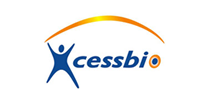
| Molecular Weight: | 410.39 |
| Formula: | C18H21F3N6O2 |
| Purity: | ≥98% |
| CAS#: | 944396-07-0 |
| Solubility: | DMSO up to 100 mM |
| Chemical Name: | 5-(2,6-dimorpholinopyrimidin-4-yl)-4-(trifluoromethyl)pyridin-2-amine |
| Storage: | Powder:4oC 1 year. DMSO:4oC3 month;-20oC 1 year. |
Biological Activity:BKM120 (NVP-BKM120) is a potent and selective, orally available pan-class I phosphatidylinositol 3-kinase (PI3K) inhibitor. It inhibits all four class-I PI3K isoforms in biochemical assays with IC50 ~50-250 nM, but exhibits selectivity of >100 folds against other protein kinases. It is also active against the most common somatic PI3Ka mutations but does not significantly inhibit the related class-III (Vps34) and class-IV (mTOR, DNA-PK) PI3K kinases. BKM120 has shown to significantly inhibit cell growth and induce apoptosis in a variety of tumor cell lines as well as in animal models. Consistent with its mechanism of action, NVP-BKM120 decreases the cellular levels of p-Akt in relevant models, as well as modulates downstream effectors in a concentration dependent and pathway-specific manner.
How to Use:
- In vitro: BKM120 was typically used at 1 µM in vitro and cellular assays.
- In vivo: BKM120 was formulated in NMP/PEG300 (10/90, v/v) and orally dosed to mice at 10 mg/kg once per day.
Reference:
- 1. Maira SM, et al. Identification and characterization of NVP-BKM120, an orally available pan-class I PI3-kinase inhibitor. (2012) Mol Cancer Ther. 11(2):317-28.
- 2. Koul D, et al. Antitumor activity of NVP-BKM120--a selective pan class I PI3 kinase inhibitor showed differential forms of cell death based on p53 status of glioma cells. (2012) Clin Cancer Res. 18(1):184-95.
- 3. Park E, et al. NVP-BKM120, a novel PI3K inhibitor, shows synergism with a STAT3 inhibitor in human gastric cancer cells harboring KRAS mutations. (2012) Int J Oncol. 40(4):1259-66
- 4. Brachmann SM, et al. Characterization of the mechanism of action of the pan class I PI3K inhibitor NVP-BKM120 across a broad range of concentrations. (2012) Mol Cancer Ther.
- 5.Ren H, et al. The combination of RAD001 and NVP-BKM120 synergistically inhibits the growth of lung cancer in vitro and in vivo.
 BKM120_spec.pdf
BKM120_spec.pdf BKM120_MSDS.pdf
BKM120_MSDS.pdf
Products are for research use only. Not for human use.
ebiomall.com






>
>
>
>
>
>
>
>
>
>
>
>
、
Cell-Based ELISA
的优点:
Cell-Based ELISA
(基于细胞的
ELISA
)是一种全新的
ELISA
技术,有两个最突出的优点:
1.1
不需要抽提蛋白、包被微孔板:细胞直接在微孔板里培养,待检测的时候,将细胞固定在微孔板上并
进行通透处理即可。这样就避免了抽提蛋白时,由于客观和主观上引起样品的损失而导致实验结果在一定
程度上偏离了实际情况。
同时不用包被微孔板,
简化了实验流程,
有助于提高效率。
科研人员在一个
96
孔
酶联板上,便能检测目标细胞蛋白经刺激或抑制作用后的表现。由于省去抽提蛋白和裂解细胞的步骤,样
本的损失也能降到最低,比起其他普通的
ELISA
测定方法,这项全新的
ELISA
技术能更快速、更方便
地一次检测大量的细胞内蛋白。
1.2
可同时检测两种不同蛋白:
封闭后加入两种抗不同蛋白且来源于不同宿主的一抗,
然后再加入不同的
二抗,加入两种荧光底物,检测两个波长。同时检测两种蛋白的好处是显而易见的,可以减少工作量,此
外还可以满足一些特殊的实验需要,例如,需要测定某个蛋白的磷酸化比例,就需要测定磷酸化蛋白的数
量和总蛋白的数量,这两个测定在同一次实验进行,有助于消除实验误差,得到更为精确的实验结果。
2
、
Cell-Based ELISA
的两种技术:
某些公司发展了双通道
Cell-Based ELISA
技术;
双通道与单通道
Cell-based ELISA
比较:
双通道
cell-based ELISA
,顾名思义,即一次可以同时检测两种目的蛋白,
R&D Systems
提供的
Cell-based ELISA
就是双通道
cell-based ELISA
,原理略:(需要荧光检测方式和相应仪器);
单通道
cell-based ELISA
,即一次只能检测一种目的蛋白,他和普通
ELISA
的主要区别在于样品处理过
程
3
、
cell-based ELISA
的应用:
该产品,最多发展起来的是用于检测磷酸化和非磷酸化蛋白的相对含量;
4
、有
cell-based ELISA
产品的公司:目前,多家
elisa
产品提供
商均
提供
cell
based
elisa
试剂盒,
如
Rnd
systems
,
raybiotech
,
ebioscience
,
millipore
等公司;
5
、如何自己进行
cell based elisa
实验?
事实上,根据单通道的
cell based elisa
原理,可以自己建立
cell based elisa
实验系统;
细胞加入培养板中;
加入刺激物或者抑制剂进行培养;
对细胞进行固定或者封闭;
加入第一抗体;
加入
HRP
结合的二抗(二抗的选择,同
western blot
);
加入底物进行显色;
我做的是细胞因子的刺激和抑制某条通路后观察是否有影响,分组为空白组,空白+抑制剂,刺激组,刺激+抑制剂,最开始用的单因素方差分析,LSD-T和SNK-Q检验,但是同学说我这里面有两个处理因素,所以不能单因素方差分析,应该直接空白和空白+抑制,空白和刺激,刺激和刺激+抑制剂进行独立样本T检验,现在脑子是混乱的,拜托园子里的大神们帮我看看,感激不尽!!
支原体培养则是取样后在培养基上培养,看有多少支原体菌落会长出,是比较直观和可信的结果。
总体来讲,这两种检查手段可信度都较高,结合一起,不仅可以可靠的知道有无解脲支原体感染,还能知道感染是否严重。
认领翻译的战友请跟帖注明“认领本文翻译,48小时内未完成,请其他站友认领”
MaggotsFasterThanScalpelinWoundDebridement
December19,2011—Maggotdebridementtherapy(MDT)appearstobemoreeffectiveforwounddebridementcomparedwithconventionaltherapy,butonlyat1week;afterthattime,anothertypeofdressingshouldbeused,newresearchsuggests.
KristinaOpletalovà,MD,fromtheDepartmentofDermatology,UniversityofCaen,France,andcolleaguespublishedonlineDecember19intheArchivesofDermatology.
MedicalmaggotswereapprovedbytheUSFoodandDrugAdmiNISTrationasamedicaldeviceforwounddebridementin2004.Accordingtotheresearchers,useofmaggotsintreatingwoundsisassociatedwitheffectivewounddebridement,antibacterialeffects,andstimulationofwoundhealing.
However,theypointout,"[r]elativelyfewclinicalstudieshavebeenconductedandtheresultsarenotclear,partlyowingtomethodologicassessmentproblems."
InthecurrentProspective,randomizedcontrolled,phase3clinicaltrial,theresearcherssoughttodeterminetheefficacyofbaggedlarvaeonwounddebridementincomparisonwithconventionaltreatment.
TheprimaryobjectivewastocomparethemeanpercentageofsloughinwoundstreatedwithMDTwiththatofconventionaltreatmentatday15.Thestudyincluded119patientswithanonhealing,sloughywoundthatwas40cm2orsmallerandlessthan2cmdeep.Patientsalsohadananklebrachialindexof0.8orhigher.
Treatmentwasadministeredduringa2-weekhospitalstay.Conventionaltreatmentconsistedofsurgicaldebridement3timesaweekwithascalpel,withuseoftopicalanesthesia.TheMDTwasadministeredusinganencloseddressing(Vitapad,BioMondeLaboratories)containing80sterilemaggots.Atdischarge,aconventionaldressingwasapplied,andpatientswerefollowed-upatday30.
DebridementbyMDTwassignificantlyfasterthansurgicaldebridementduringthefirstweekoftreatment,reachingthesamelevelthecontrolgroupreachedatday15.NobenefitforMDTcomparedwithconventionaltreatmentinhealingrateswasobserved.Atday8,54.5%intheMDTgroupvs66.5%inthecontrolgroup(P=.04)hadevidenceofsloughandwoundhealing.However,byday15,themeanpercentageofsloughwas55.4%intheMDTgroupand53.8%inthecontrolgroup(P=.78).
"AthoughMDTshowsnosignificantbenefitatday15comparedwithconventionaltreatment,debridementbyMDTissignificantlyfasterandoccursduringthefirstweekoftreatment,"theresearchersconclude."Becausethereisnobenefitincontinuingthetreatmentafter1week,anothertypeofdressingshouldbeusedafter2or3applicationsofMDT."
Painscoresweresimilarandmildinbothgroups,althoughincontrasttoconventionaltreatment,MDTwasperformedwithouttopicalanesthesia.
Accordingtotheresearchers,noneofthepatientswerereticentaboutundergoingMDT."[A]crawlingsensationonthewoundwasrarelyandalmostequallynotedinbothgroups,revealingthatthesensationwassubjective,"Dr.Opletalovàandcolleaguespointout.
TwoquestionsregardingMDTremainunanswered,theauthorsnote."Candebridementbeimprovedusingmoremaggotsperdressing?Ifso,wouldthesedressingsbemorepainful?Furtherstudiesareneededtoanswerthesequestions."
ThestudywassupportedbygrantsfromtheClinicalResearchHospitalProgramandfromtheFrenchSocietyofDermatology.Theauthorshavedisclosednorelevantfinancialrelationships.









